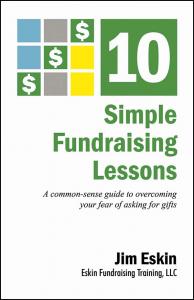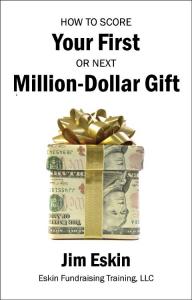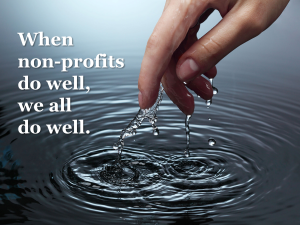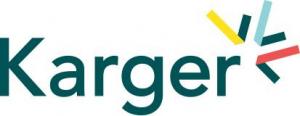Philanthropy — an annual enterprise of nearly $600 billion — can take actionable measures to achieve even greater impact in championing good works.
SAN ANTONIO, TX, UNITED STATES, October 28, 2025 /EINPresswire.com/ — The current fiscal environment isn’t pretty. Essential programs and services providing much needed support from the federal government to segments of the American population that are at the greatest risk are being compromised.
Sadly, problems are only growing worse. With the September 30th deadline passed and another government shutdown underway, the charitable sector faces renewed financial uncertainty and severe strain on non-profit capacity. This disruption follows months of fiscal uncertainty, as non-profits were already contending with major reductions in federal grants and cuts to social safety net programs such as SNAP, student loan forgiveness, and Medicare. The loss of millions in critical funding during the first half of 2025 is now compounded by the wider economic impact of the shutdown.
While Washington is torn apart and wrestles with coming to consensus, the charitable sector keeps the country nourished — in every sense of the meaning.
Independent Sector reports that nationwide, 1 in 3 non-profits had already reported funding freezes or stop-work orders earlier this year. The continued impasse between Republican and Democratic lawmakers now forces organizations to make difficult operational choices — cutting programs, freezing grants, and, in some cases, preparing for furloughs or layoffs. Meanwhile, an estimated 620,000 federal workers face missed paychecks, increasing demand for the very services non-profits are struggling to maintain.
Non-profits, which rely on government funding for roughly 28% of their budgets, are being pushed to serve as emergency infrastructure without the resources to do so.
The shutdown effectively disarms non-profit ability to respond to surging needs for food, housing, and direct support.
Rather than retreating from the crisis, this is a prime opportunity for American philanthropic ecosystem to shine more brightly. American philanthropy never shirks challenges, it welcomes them, stands ready to cope with dangerous crises again. Amidst feelings of gloom and doom, there are stretch but realistic responses American philanthropy can make to improve the quality of life and pave the way for a brighter, stronger and more socially just its future for citizens of all different socio-economic backgrounds. The non-profit sector needs to work hard and needs to work smart to achieve the strongest possible return on every precious donor dollar and every staff and volunteer hour invested in championing the respective noble missions.
Based on research, data, sound principles, proven strategies best practices Eskin Fundraising Training highlights the following 10 effective ways that American philanthropy can play an even more impactful leadership role.
1. Those with the capacity can be even more generous. Affluent households remain the driving force behind charitable giving in the U.S. The 2025 Bank of America Study of Philanthropy shows that high-net-worth Americans account for a substantial and growing share of the nation’s philanthropy, with their average household donations exceeding $33,000 in 2024 — more than 10 times the average for US households overall. The biennial study, based on a nationally representative sample of households with at least $1 million in net worth or $200,000 in annual income, highlights that 81% of affluent households gave to charity last year. The U.S. has more than 25 million millionaires and 1,000 billionaires. Don’t be misled by appearances. Many of them have achieved their wealth by living below their means and might live next door.
2. Take full advantage of the upcoming unprecedented Great Wealth Transfer. Donors can make gifts several times larger from their estates than current wealth. The knocking on the door has never been so loud. The Baby Boomer (and Silent) generations are projected to transfer an unprecedented $124 trillion in wealth by the year 2048. Now is the time to ramp up legacy giving infrastructure recognizing that the most popular vehicles are wills and bequests, pension funds and insurance policies.
3. Seize the enormous potential of volunteer power. In addition to providing the precious gift of time, and in doing so, empowering programs and services than would not be otherwise possible, America’s nearly 80 million volunteers are almost twice as likely to donate to a charity than those that don’t volunteer. There is no more powerful way to acquaint prospective donors with non-profit missions than engaging them and seeing close-up how non-profits the public good.
4. Embrace trust-based philanthropy. MacKenzie Scott has set an amazing example by contributing large, unrestricted gifts to more than 2,450 non-profits during the past six years. The 55-year-old donated $2 billion in 2024 alone, bringing her total gifts to more than $20 billion since 2019.
A three-year analysis from the Center for Effective Philanthropy (CEP) finds that Scott’s no-strings-attached gifts, with a median size of $5 million, have had a “transformative effect” on non-profits by helping them expand their impact and become more financially stable. When people invest in stocks, they don’t instruct the company how the money should be spent. They expect leadership to be able to make the best decisions and report on year end results and impact. Why should non-profits be treated differently?
5. Promote gifts of appreciated assets. Donors can potentially maximize the impact of giving for both themselves and charities when donating often overlooked non-cash assets, such as appreciated stocks in portfolios, privately held business interests, or even cryptocurrency.
Donating stocks directly to the charity unlocks two key tax benefits: It may eliminate capital gains taxes encountered on the sale of stock donation that is tax deductible at the current fair market value. As a result, the most long-term appreciated stock in portfolio is often the best to donate because it offers the greatest potential tax benefit. Plus, because the charity doesn’t need to pay the capital gains tax, it can sell the stock donated for its current fair market and keep 100% of the proceeds.
6. Recognize the more generous gender. Based on Ipsos research conducted with women in the U.S. with $100,000 or more in investable assets, the findings show that affluent women — particularly younger generations and women of color — are charting a new course in charitable giving. Three in five surveyed women believe financial giving is extremely or very important, but the nature of that giving is personal and grounded in immediate human needs close to home. Top areas of giving are family members (41%), human services such as food insecurity and disaster relief (36%), and health/medical causes (30%).
7. Non-profits need to collaborate, coordinate and communicate like lives depend on it. The overarching goal is to provide the most effective and efficient solutions to the myriad challenges facing the world. We don’t need more organizations but instead the most concentrated, focused, and unified investment and allocation of finite resources, especially the precious time of staff and volunteers. The most common forms are making joint requests, sharing infrastructure, and freely exchanging experiences in what works and what doesn’t.
8. Double down on retaining donors. The average non-profit donor retention rate is around 45%, though this varies significantly by donor type. For new donors, the average retention rate is much lower, at about 20%. It is such a more cost-effective tactic to concentrate on keeping current contributors than the cost, time and effort to acquire new ones.
9. Also double down on retaining fundraising staff. Fundraisers have a high turnover rate, with the average tenure being about 16 to 18 months and rarely reaching two years. This short average is due to factors like unrealistic expectations, high pressure, and inadequate support. This exacerbates the donor retention challenge. Since contributors, especially major gift donors, prefer to keep working with staff that they know, like and trust, it is worth every dollar to hold onto high performing staff.
10. Monthly needs more money. A lot has changed in the fundraising world — but one thing that hasn’t is that monthly giving remains the most productive and efficient way to develop resources to advance the mission. Programs are simple to design, implement and maintain. There are many compelling reasons to promote this proven strategy at every possible opportunity including greater lifetime giving, higher retention, potential to develop major and legacy gift pipelines and other capacity building benefits. The supporting data and evidence are overwhelming.
Philanthropy is composed of kindred spirits of true believers in welcoming responsibility for touching, improving and saving more lives, especially helping those who are struggling. By helping others, we are truly helping ourselves. Research documents that those who donate precious gifts of time and money lead longer, healthier and happier lives.
It can seem like the problems surrounding us are so overwhelming that we don’t know where to start. But by living the spirit of Abraham Lincoln’s “better angels of our nature,” and reading to one child at a time, putting a smile on the face of one senior at a time, fostering one stray cat or dog at a time, introducing the arts to one underserved person at a time and a host of other ways engaging with one person at a time, we reinvigorate the sense of hope that more is possible and perpetuate the American tradition that sharing and caring for one another is an awesome, plentiful and renewable fountain of hope.
Jim Eskin
Founder
Eskin Fundraising Training
10410 Pelican Oak Drive
San Antonio, TX 78254-6727
Cell: 210.415.3748
E-Mail: jeskin@aol.com
www.eskinfundraisingtraining.com
About Eskin Fundraising Training
After a successful career leading advancement for three institutions of higher education, Jim Eskin’s consulting practice, Eskin Fundraising Training, launched in 2018, builds on the success of more than 250 fundraising workshops, webinars, webcasts, podcasts and board sessions, and provides the training, coaching and support services to equip non-profit leaders to replace fear of fundraising with comfort and confidence. He has authored more than 150 guest columns that have appeared in daily newspapers, business journals and blogs across the country. He publishes Stratagems, a monthly e-newsletter exploring timely issues and trends in philanthropy. Sign up here for a free subscription. You will also receive invitations to free virtual learning community programs. He is author of 10 Simple Fundraising Lessons, an 82-page common sense guide to understanding the art and science of fundraising, and How to Score Your First or Next Million-Dollar Gift, 104 pages filled with strategies, best practices and homework assignments to unlock exciting opportunities that elevate organizational impact to the next level. Both are available in print and digital formats through Pathway, the book distributor, and Amazon. Quantity discounts are available to non-profits who want to share books with teams of management, development staff, board and volunteers. Eskin is also available for customized virtual training for boards, staff, and fundraising committees. His newest customized service, Fundraising Urgent Care, offers 48-hour turnaround in addressing general strategy and tactical challenges that require immediate responses.
FOR MORE INFORMATION:
Jim Eskin
Founder
Eskin Fundraising Training
10410 Pelican Oak Drive
San Antonio, TX 78254-6727
Cell: 210.415.3748
E-Mail: jeskin@aol.com
www.eskinfundraisingtraining.com
Links
Website: www.eskinfundraisingtraining.com
Newsletter sign-up: https://lp.constantcontactpages.com/sl/36Wz1P1
10 Simple Fundraising Lessons purchase: www.pathwaybookservice.com/products/10-simple-fundraising-lessons
How To Score Your First or Next Million-Dollar Gift purchase:
Nominate Your Non-Profit North Star Podcast:
https://lp.constantcontactpages.com/sv/x1rYzFO
Jim Eskin
Eskin Fundraising Training LLC
+1 210-415-3748
email us here
Visit us on social media:
LinkedIn
Facebook
Legal Disclaimer:
EIN Presswire provides this news content “as is” without warranty of any kind. We do not accept any responsibility or liability
for the accuracy, content, images, videos, licenses, completeness, legality, or reliability of the information contained in this
article. If you have any complaints or copyright issues related to this article, kindly contact the author above.
![]()








